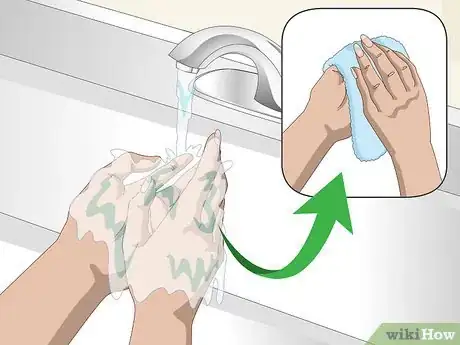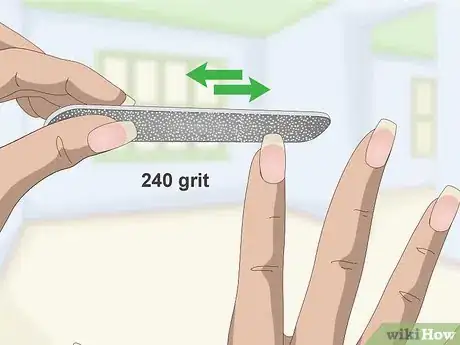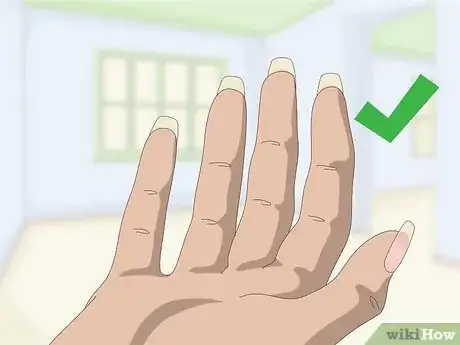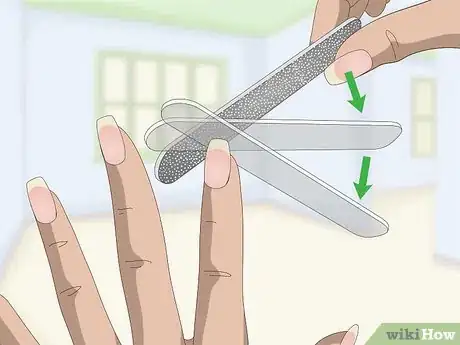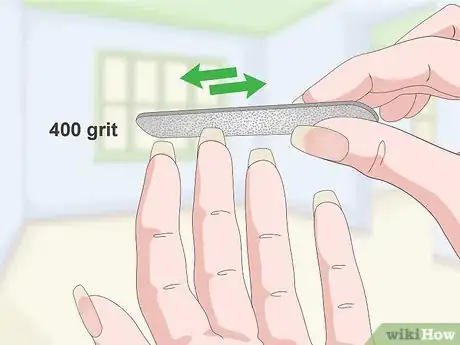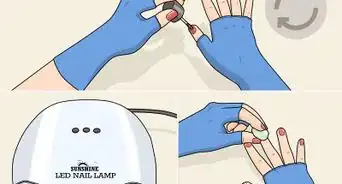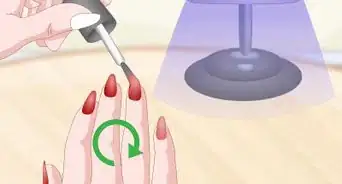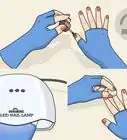This article was co-authored by Marta Nagorska. Marta Nagorska is a Nail Technician and Nail Art Blogger based in London, UK. She runs the blog, Furious Filer, where she gives tutorials on nail care and advanced nail art. She has been practicing nail art for over 5 years and graduated from Northampton College with distinction with a Nail Technician and Manicurist degree in 2017. She has been awarded the top spot in the OPI Nail Art Competition.
There are 8 references cited in this article, which can be found at the bottom of the page.
This article has been viewed 62,472 times.
Squoval nails are a combination of the square and oval shapes. They’re a modern and universally flattering shape with a flat, or square, top edge and slightly rounded corners. It’s easy to file your nails into a squoval shape at home using a nail file for shaping and finishing. After they’re filed, you can add polish for a pop of color or leave them natural.
Steps
Shaping the Nail
-
1Wash and dry your hands. Cleanse your hands with warm water and gentle hand soap to get rid of extra oil on your nails and hands. Rinse your hands, and dry them completely with a towel.[1]
- Wait 3-5 minutes before filing as wet nails can be more easily damaged than dry nails.
-
2Trim your nails into a squoval shape. If your nails aren't already close to being squoval, you may want to start by trimming them into the correct general shape. Use a sharp, clean pair of manicure scissors to trim off angular edges and any unwanted length to create a rough squoval template. Trim slowly and carefully, making sure not to cut into your skin.[2]
- You can use a picture for reference if you are unsure about the exact shape you are trying to achieve.
- You will be able to refine the shape more when you file.
Advertisement -
3File the top edge of each nail straight across using a 240-grit file. This top edge is called the “free edge” of the nail, where the nail ends at the tip of the finger.[3] Hold the file between your thumb and index finger, making sure it is positioned at a slight angle to the nail's edge. Run the file across the free edge in one direction 3-4 times, taking care to avoid filing against the skin of your finger.[4]
- Be gentle at first, to make sure your nails are strong enough to handle the filing. If you do get breakage while you’re filing, stop immediately and apply strengthening nail oil to the nail. Wait 1-2 weeks to try filing again.
- Avoid using a back and forth motion to file, as this can cause cracking and splitting.
-
4Check your nails from underneath to make sure the free edge is flat. Position your hands with the palms up and look at your nails. From this angle, check to make sure the tops of your nails are not slanted to one side or another.[5]
- If they are slanted, you can use your 240-grit file to make adjustments as needed. Check the nails again once you feel they’re straight.
-
5Hold the file under the nail corner, tilt it 45 degrees, and round the corner. In a smooth, rounding motion, pull the 240-grit file over the corner to create a rounded edge.[6] Do this 3-4 times, then check your work. The corner should be rounded, not flat or sharp. If it’s not rounded, file 1-2 more times using the rounding motion. Then, repeat on the other side.[7]
- Try to make both corners even, rounding off slightly to the flat edge of the nail. It’s okay if you over file your first time, the nail will grow back over time.
-
6Smooth out the areas where the corners meet the free edge. Bring your 240-grit file back to the top of your nails, and use it to soften the transition between the flat top and the rounded sides. After each stroke of the file, check your work.[8]
- It’s important to do this gradually to prevent over-filing, which can result in a more rounded look.
Finishing the Look
-
1Slide the 400-grit nail file over the top of each nail to finish the edge. Hold the 400-grit file perpendicular to the tip of your nail. Using a very small amount of force, pull the file over the edge to the top of the nail 1-2 times. This will create a “finished” edge to protect your nail.[9]
- Do this very gently to avoid cracking and splitting.
-
2Remove any stray nail filings with a dust brush or cotton ball. Brush over your nails with a soft dust brush or a cotton ball to remove nail dust and lift any loose pieces of nail. Wipe under each nail, as well, to remove dust and filings.[10]
- If you have small pieces of nail leftover from filing that are still attached to the nail, use your 240-grit file to very gently remove the pieces by running the edge of the file over them 1-2 times. This will cause them to detach from the nail. Be careful not to change the shape of the nail as you do this.
-
3Use a buffer to smooth the surface of your nails. Rub a nail buffer horizontally over the surface of your nails with a vigorous back and forth motion. This smoothes out imperfections in the nails that you can’t address with a file.[11]
- If you’re planning to polish your nails, buffing can help the polish spread evenly across the nails. It would also be helpful to push back your cuticles to ensure smooth polish applications.
- If you aren't planning to use nail polish, consider putting a drop of top coat on your nail before you buff. This will create a natural-looking luster.
-
4Polish your nails with base coat, color, and topcoat. Apply a thin coat of protective base coat to your first nail and allow it to dry while you polish your other nails. 2 coats of nail polish in your favorite color, waiting 5 minutes in between coats. Finish with a layer of strengthening top coat. Wait 20-30 minutes for your nails to completely dry.[12]
- If you don’t want to use color, you can apply only the base coat and top coat layers, which will protect your nails and give them a glossy appearance.
Expert Q&A
-
QuestionWhat nail shape is best for your hands?
 Laura MartinLaura Martin is a Licensed Cosmetologist in Georgia. She has been a hair stylist since 2007 and a cosmetology teacher since 2013.
Laura MartinLaura Martin is a Licensed Cosmetologist in Georgia. She has been a hair stylist since 2007 and a cosmetology teacher since 2013.
Licensed Cosmetologist The best nail shape is one that flatters the shape of your natural nail and fingers. For example, if you have long thin fingers an oval nail is a flattering choice.
The best nail shape is one that flatters the shape of your natural nail and fingers. For example, if you have long thin fingers an oval nail is a flattering choice. -
QuestionWhat does "squoval" mean?
 Laura MartinLaura Martin is a Licensed Cosmetologist in Georgia. She has been a hair stylist since 2007 and a cosmetology teacher since 2013.
Laura MartinLaura Martin is a Licensed Cosmetologist in Georgia. She has been a hair stylist since 2007 and a cosmetology teacher since 2013.
Licensed Cosmetologist Squoval is a square shape with rounded edges. It's a hybrid of square and oval nail shapes.
Squoval is a square shape with rounded edges. It's a hybrid of square and oval nail shapes. -
QuestionHow do you cut toenails?
 Laura MartinLaura Martin is a Licensed Cosmetologist in Georgia. She has been a hair stylist since 2007 and a cosmetology teacher since 2013.
Laura MartinLaura Martin is a Licensed Cosmetologist in Georgia. She has been a hair stylist since 2007 and a cosmetology teacher since 2013.
Licensed Cosmetologist You should use a clipper specially designed for the toenail since they are tougher than fingernails. Cut straight across to prevent ingrown nails.
You should use a clipper specially designed for the toenail since they are tougher than fingernails. Cut straight across to prevent ingrown nails.
Warnings
- Wait 2-4 weeks between filing your nails. Filing too often can cause breakage and damage to the stress point of the nail, and it can result in weakened nails over a long period of time.⧼thumbs_response⧽
- Avoid your skin when filing, as the grit of the file can cause minor irritation.⧼thumbs_response⧽
Things You’ll Need
- Soap, water, and clean towel
- 240-grit nail file
- 400-grit nail file
- Dust brush or cotton ball
- Nail buffer
- Base coat and top coat (optional)
- Nail polish (optional)
References
- ↑ https://www.cdc.gov/healthywater/hygiene/hand/nail_hygiene.html
- ↑ https://www.more.com/beauty/nails/nail-care/how-shape-your-nails
- ↑ Marta Nagorska. Nail Artist. Expert Interview. 26 May 2021.
- ↑ http://www.nailsplash.com/page/101
- ↑ http://www.nailsplash.com/page/101
- ↑ Marta Nagorska. Nail Artist. Expert Interview. 26 May 2021.
- ↑ https://naildesigns.com/squoval-nails-tutorial/
- ↑ https://naildesigns.com/squoval-nails-tutorial/
- ↑ http://www.nailsmag.com/encyclopedia/82164/squoval
About This Article
Squoval nails have a flat, square top edge with slightly rounded corners. Start by cutting your nails to this shape if they're not already. Then, file them with a 240-grit file. File your nails in one direction, instead of back and forth, so you don’t risk cracking them. After that, go over your nails with a 400-grit file and rub them with a buffer to smooth out the edges. For more tips from our Beauty co-author, including how to polish your squoval nails, read on!
